
Browse an alphabetical list of photographs. These historical images portray people, places, and events before, during, and after World War II and the Holocaust.
<< Previous | Displaying results 1001-1050 of 2641 for "Photo" | Next >>
An SS officer standing in front of a newly constructed gallows in the forest near Buchenwald concentration camp. Buchenwald, Germany, April 1942.
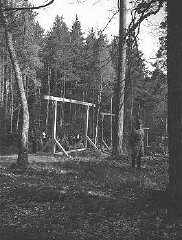
Garber family photograph, likely taken in Zehlendorf, Berlin, circa 1946. Magdalene Garber and her husband Jack Goodwin (an African American GI) had a house in Zehlendorf. This photo was most likely taken in their garden. Standing left to right are Käthe Garber (‘an aunt’ according to the original caption), Magdalene, Joseph Garber, and Helga Naue (future wife of Hans Garber). The man kneeling is Hans Garber (Magdalene's brother). Joseph is wearing Jack Goodwin’s hat (Magdalene's…
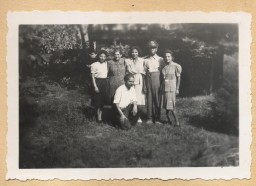
Family portrait of the Gartenberg family in Drohobycz, Poland. None of those pictured would survive the Holocaust. Photograph taken in 1930. Top row: Julius Gartenberg, Anna Fern, Bernard Klinger, Ona Fern and Izador Gartenberg. Lower row: Marcus Gartenberg, Hinda Gartenberg with her grandaughter Tony Schwartz on her lap, Sol Schwartz, and Ida Fern.
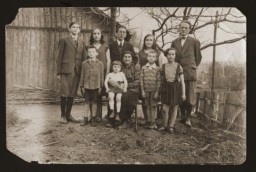
Interior of a gas chamber at the Majdanek camp. Majdanek, Poland, after July 24, 1944.
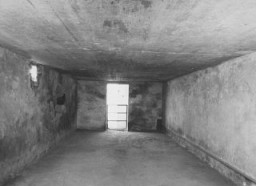
Postwar photograph of gas chamber for mass murder in the Auschwitz main camp. Poland, ca. 1947. In mid-August 1940, Auschwitz concentration camp authorities put into operation a crematorium adjacent to a morgue. This building was located just outside the boundaries of the Auschwitz main camp. In September 1941, the morgue was converted to a gas chamber for mass murder where several hundred people could be killed at a time. This gas chamber was used until December 1942, though the crematorium remained…
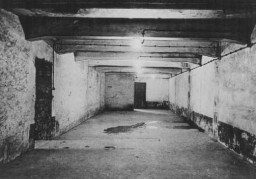
Gavra Mandil celebrates his fourth birthday with his parents, Mosa and Gabriela, and sister Irena. Novi Sad, Yugoslavia, September 6, 1940.
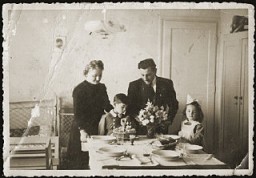
Gavra Mandil and his family narrowly escaped death in German-held Yugoslavia by fleeing to Italian-occupied Albania. There Gavra attended a school in Kavaja that had both Muslim and Christian pupils. He is seated on the far right in the first row. June 1943.
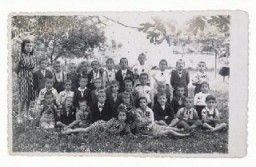
General Dwight D. Eisenhower (center), Supreme Allied Commander, views the corpses of inmates who died at the Ohrdruf camp. Ohrdruf, Germany, April 12, 1945.
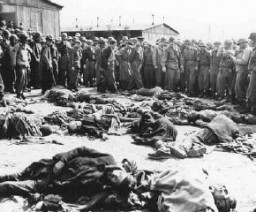
General Dwight D. Eisenhower visits with paratroopers of the 101st Airborne Division just hours before their jump into German-occupied France (D-Day). June 5, 1944.
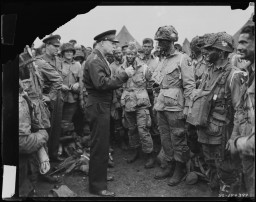
While touring the newly liberated Ohrdruf camp, General Dwight Eisenhower and other high ranking US Army officers view the bodies of prisoners who were killed during the evacuation of Ohrdruf. Ohrdruf, Germany, April 12, 1945.
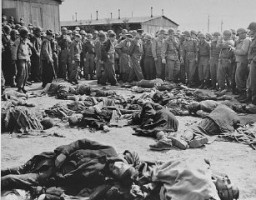
George Mandel-Mantello greets the Satmar Rebbe, Joel Teitelbaum, upon his arrival in Switzerland on the Kasztner transport from Bergen-Belsen. Switzerland, December 1944.
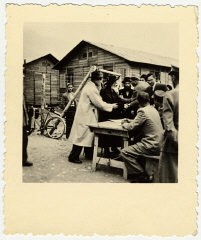
On July 14, 1933, the Nazi dictatorship enacted the Law for the Prevention of Offspring with Hereditary Diseases. Individuals who were subject to the law were those men and women who “suffered” from any of nine conditions listed in the law: hereditary feeblemindedness, schizophrenia, manic-depressive disorder, hereditary epilepsy, Huntington’s chorea (a rare and fatal degenerative disease), hereditary blindness, hereditary deafness, severe physical deformity, and chronic alcoholism. Gerda D., a…
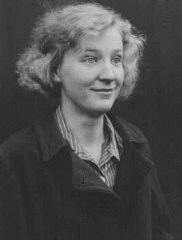
Dr. Gerhart Riegner, World Jewish Congress representative in Geneva, Switzerland, sent a cable in August 1942 to American Jewish leader Stephen S. Wise about the Nazi plan to exterminate European Jewry. Date uncertain.
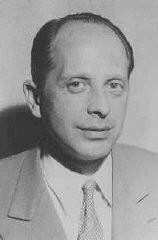
SS troops unload artillery at a river crossing on the way to the front. Soviet Union, October 1941.
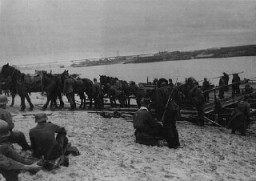
German boys read an issue of Der Stuermer newspaper posted in a display box at the entrance to a Nazi Party headquarters in the Dresden region. The German slogan (partially obscured) at the bottom of the display box reads, "The Jews are our misfortune."
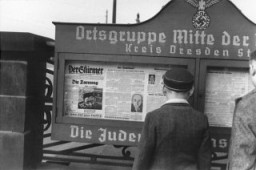
German children read an anti-Jewish propaganda book for children titled Der Giftpilz (The Poisonous Mushroom). The girl on the left holds a companion volume, the translated title of which is "Trust No Fox." Germany, ca. 1938. (Source record ID: E39 Nr .2381/5)
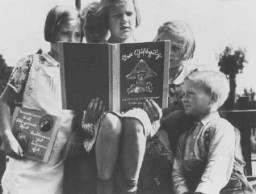
German civilians under US military escort are forced to view a wagon piled with corpses in the newly liberated Buchenwald concentration camp. Buchenwald, Germany, April 16, 1945.
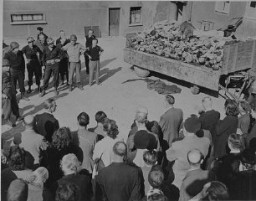
African American soldiers of the US Army escort German civilians through a site where camp prisoners were massacred during a death march from Buchenwald. Such tours forced Germans to recognize the crimes committed by the SS. Near Nammering, Germany, 1945.
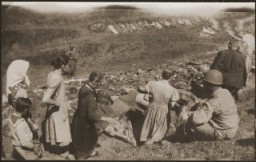
German civilians from the town of Nammering, under orders of American military authorities, dig graves for victims of a death march from the Buchenwald concentration camp. Germany, May 1945.
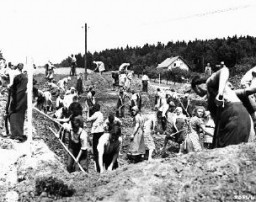
Under the supervision of the US First Army, German civilians from Nordhausen carry victims of the Dora-Mittelbau concentration camp to mass graves. Germany, April 14, 1945.
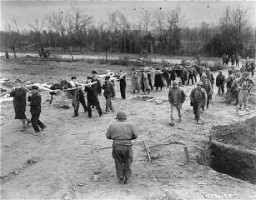
German civilians from Schwarzenfeld dig graves for the reburial of 140 Hungarian, Russian, and Polish Jews exhumed from a mass grave near the town. The victims died while on an evacuation transport from the Flossenbürg concentration camp. Schwarzenfeld, Germany, April 25, 1945. Following the discovery of death march victims, US Army officers forced local Germans to view the scene of the crime and ordered the townspeople to give the victims a proper burial.
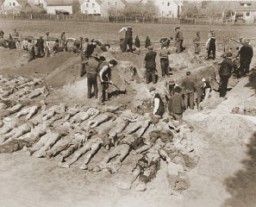
Under orders from officers of the US 8th Infantry Division, German civilians from Schwerin attend funeral services for 80 prisoners killed at the Wöbbelin concentration camp. The townspeople were ordered to bury the prisoners' corpses in the town square. Germany, May 8, 1945.
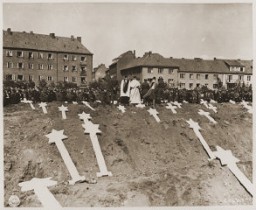
Under orders of the US First Army, German civilians prepare to use a stretcher to remove corpses of victims of the Dora-Mittelbau concentration camp, near Nordhausen. Germany, April 13–14, 1945.

German civilians remove the bodies of prisoners killed in the Nordhausen concentration camp and lay them out in long rows outside the central barracks (Boelke Kaserne). Nordhausen, Germany, April 12, 1945. This image is among the commonly reproduced and distributed, and often extremely graphic, images of liberation. These photographs provided powerful documentation of the crimes of the Nazi era.
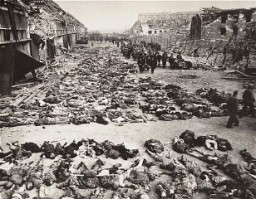
Under the supervision of American medics, German civilians file past the bodies of Jewish women exhumed from a mass grave in Volary. The victims died at the end of a death march from Helmbrechts, a subcamp of Flossenbürg. Germans were forced to exhume them in order to give the victims proper burial. Volary, Czechoslovakia, May 11, 1945.

German civilians from the town of Nordhausen carry the bodies of prisoners found in the Nordhausen concentration camp to mass graves for burial. Nordhausen, Germany, April 13-14, 1945.
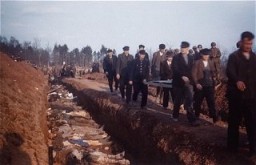
German civilians conscripted from nearby towns dig graves for some of the victims of the Ohrdruf camp. Ohrdruf, Germany, April 1945.
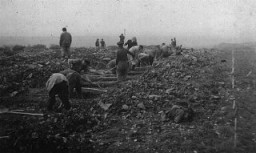
The Germans destroyed symbols of the Polish state. Here, German soldiers stand by the toppled Grunwald monument in Krakow. Poland, 1940.
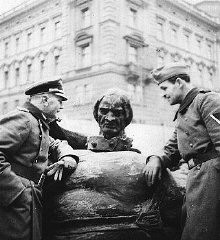
US Army staffers organizing stacks of German documents collected by war crimes investigators as evidence for the International Military Tribunal.
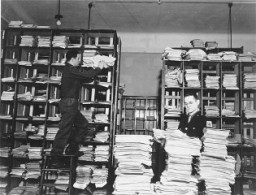
By 1922, The International Jew was already in its 21st printing in Germany. The edition shown here was published in Leipzig in 1922.
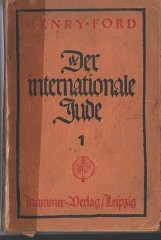
German forces enter Aachen, on the border with Belgium, following the remilitarization of the Rhineland. Aachen, Germany, March 18, 1936.
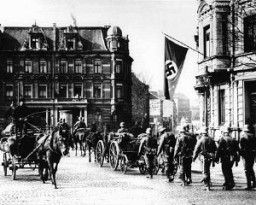
Pictured from left to right: Field Marshal Paul von Hindenburg, Kaiser Wilhelm II, and General Erich Ludendorff study maps during World War I. January 1917.
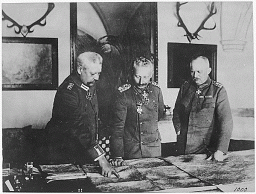
Group portrait of German girls posing outside their school in front of a Nazi flag. Among those pictured is Lilli Eckstein six months before she was expelled from the school for being Jewish. Heldenbergen, Germany, 1935.

German Jewish adults and children wearing compulsory Jewish badges are lined up against a building. Weser, Germany, 1941–43.

German Jewish refugee artist David Bloch. In November 1938 Bloch was interned for several weeks in the Dachau concentration camp near Munich. With the help of his brother in the United States, he escaped from Germany to Shanghai in May 1940.

German Jewish refugee Erwin Eisfelder stands outside Cafe Louis on Ward Road. The cafe was named in honor of his father. It was a popular gathering place for refugees in Shanghai during the war years. Shanghai, China, ca. 1944.
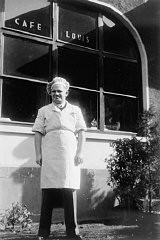
Two German Jewish refugee women stand behind the counter of the Elite Provision Store (delicatessen) in Shanghai. Pictured on the left is the owner, Gerda Harpuder; on the right is her cousin Kate Benjamin. In 1939 Hans and Gerda Harpuder sold their crystal, silver, and other family possessions shipped from Berlin in order to open a grocery store in Hongkew at 737 East Broadway.
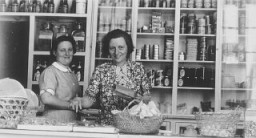
Two German Jewish women wearing the compulsory Jewish badge. Germany, September 27, 1941.
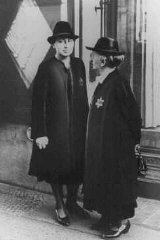
German Jews trying to emigrate to Palestine form long lines in front of the Palestine and Orient Travel Agency. Berlin, Germany, January 22, 1939.
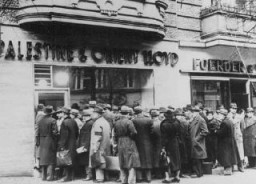
A US soldier stands guard as mayors and citizens of local towns view the corpses of inmates of the Rottleberode subcamp of Dora-Mittelbau, who were killed when the SS locked them in a barn and set it on fire. Gardelegen, Germany, April 18, 1945.
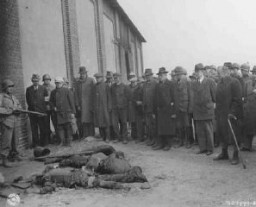
After liberation of the Bergen-Belsen camp, British soldiers forced German mayors from nearby towns to view mass graves. Bergen-Belsen, Germany, after April 15, 1945.
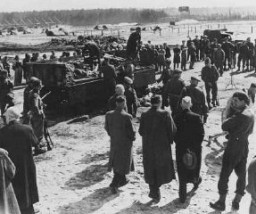
A German soldier guards a group of Poles and Jews who have been rounded-up and forced to stand in a line with their arms raised, Poland, September 1939.

German officers review their orders during the invasion of the Soviet Union in 1941.
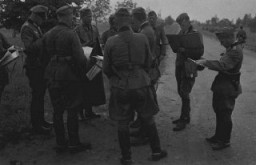
A member of the German Order Police Battalion 101 stands next to a sign marking the entrance to the Lodz ghetto in German-occupied Poland, 1940–1941. The German text of the sign reads: "Announcement: In accordance with a police order of February 8, 1940, all Germans and Poles are forbidden entry into the ghetto area."
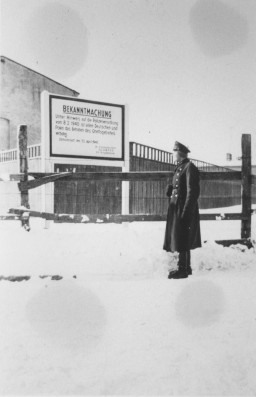
A member of the German Order Police raises a stick to beat a Jew who is loading his bundles onto a wagon during expulsion from the community of Sieradz in German-occupied Poland. Photo dated 1940–1942.
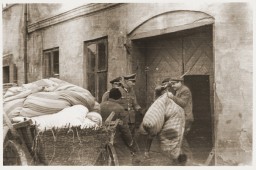
Bernhardt Colberg, a member of Reserve Police Battalion 101, poses in front of its headquarters in the vicinity of Lodz in German-occupied Poland. The police battalions were units of the German Order Police who were deployed to German-occupied areas of Europe during World War II. Photo dated 1940–1941.
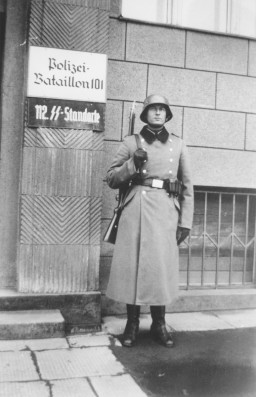
Members of the German Order Police publicly humiliate a group of Jews by forcing them to perform exercises, 1939–1940. Sosnowiec, in German-occupied Poland.
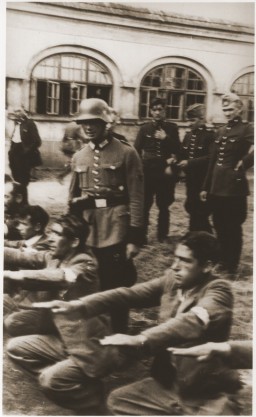
Members of the German Order Police stand guard over a group of Orthodox Jewish men, 1942. The men have been rounded-up either for forced labor or public humiliation. Krakow, in German-occupied Poland.
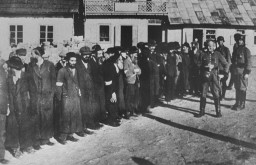
Propaganda poster depicting two Germans in the field during World War II. After the war began in 1939, Police Battalions were deployed alongside the German military. This poster was designed by SS-Hauptsturmführer Felix Albrecht in 1941.
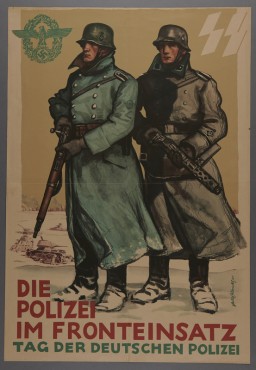
German police guard a group of Roma (Gypsies) who have been rounded up for deportation to Poland. Germany, 1940–45.
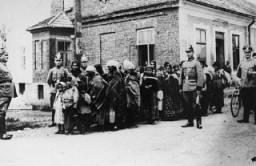
We would like to thank Crown Family Philanthropies, Abe and Ida Cooper Foundation, the Claims Conference, EVZ, and BMF for supporting the ongoing work to create content and resources for the Holocaust Encyclopedia. View the list of donor acknowledgement.